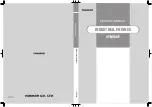
Simpli
fi
ed diagram for brake activation
1 Voltage supply
2 Button two circuit test
3 / 4
“
Open brake
”
button
6.4
Pull out of safety gear
If the car loaded with the nominal load enters the trap due to a malfunction or during the TÜV
certi
fi
cation, it is possible that the trap device is seated rather
fi
rmly. In such a case, it is entirely
possible that the drive torque is no longer suf
fi
cient to pull the car out of the trap.
With gearless drives in machine rooms, a handwheel does not make any sense because there is no
gear reduction. That is because due to the low moment arm of force, only slight force can be applied.
A handwheel could even present a hazard, as even with only a slight imbalance in the installation, it is
no longer possible to stop the elevator with the handwheel.
With gearless drives in the shaft, the motor is usually not accessible. A handwheel is unnecessary in
such a layout.
In both cases with gearless drives, applicable is: One must fall back on a chain hoist or similar if the
drive torque is insuf
fi
cient or if there is a lack of drive on the rope. It makes sense to keep a suitable
chain hoist ready during the TÜV inspection.
Note
Note that an overload in the car leads to an increase in the motor torque. 25 % overload results in
150 % of the required motor torque! As regulated drives are normally designed for a maximum torque
of ca. 170 - 200 %, only slight reserves are available during such special cases.
For that reason it is recommended, just as described in EN 81-1 Appendix D.2 j), to perform a TÜV
trap inspection in the door area so that the car can be unloaded there to relieve the drive.
2ULJLQDORSHUDWLQJLQVWUXFWLRQV
ZAtop
–
model series SM225.40B
Start-up
A-TBA13_06-GB
Part.-No. 01009090-GB (
(8%'
)
15/72
















































